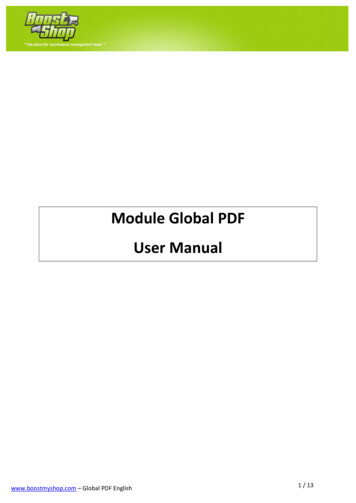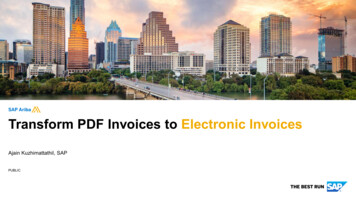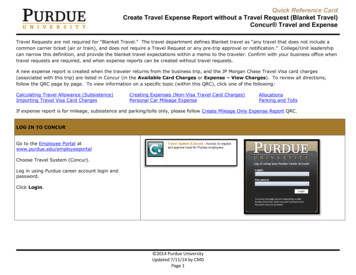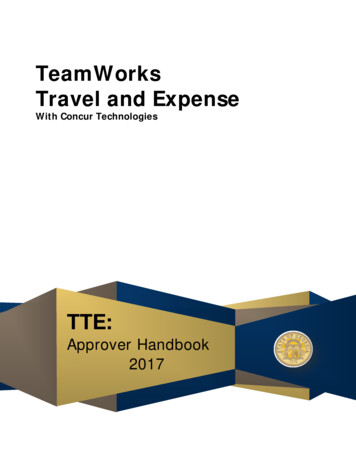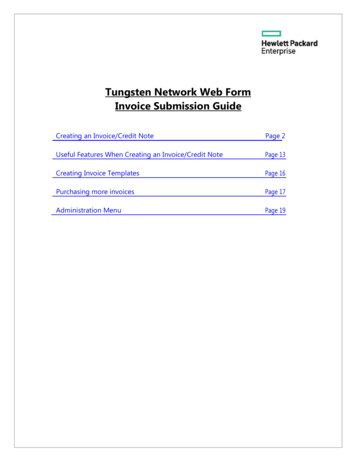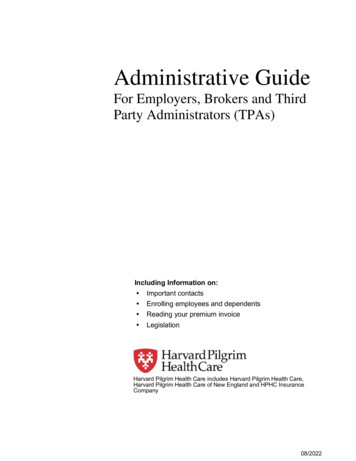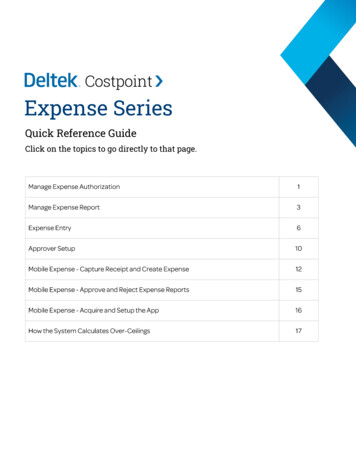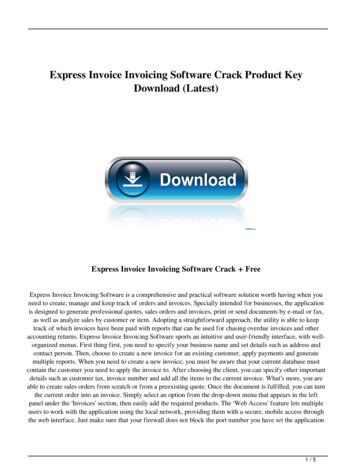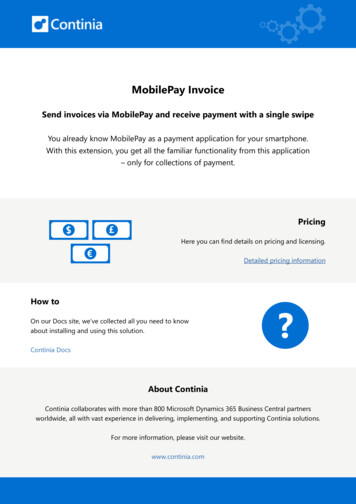
Transcription
A Forrester ConsultingThought Leadership PaperCommissioned By SAP ConcurDecember 2019Improve Travel, Expense,And Invoice ManagementTo Drive Better EmployeeExperienceWhy Finance, IT, And HR Must Collaborate ToBetter Serve Employees And The Business
Table Of Contents1 Executive Summary2 Good Employee Experience IsCritical To Business Success3 T&E And Invoice ManagementSoftware Play A Critical Role InEnabling Good EX6 T&E And Invoice ManagementCan Be Time-Consuming AndTedious, Frustrating Employees AndManagers Alike9 Firms Need Both The Right ToolsAnd The Right OrganizationalStructure To Improve T&E AndInvoice Management And Boost EX12 Key Recommendations13 AppendixABOUT FORRESTER CONSULTINGProject Director:Rachel Linthwaite,Senior Market Impact ConsultantContributing Research:Forrester’s CIO research groupForrester Consulting provides independent and objective research-basedconsulting to help leaders succeed in their organizations. Ranging in scope froma short strategy session to custom projects, Forrester’s Consulting servicesconnect you directly with research analysts who apply expert insight to yourspecific business challenges. For more information, visit forrester.com/consulting. 2019, Forrester Research, Inc. All rights reserved. Unauthorized reproductionis strictly prohibited. Information is based on best available resources.Opinions reflect judgment at the time and are subject to change. Forrester ,Technographics , Forrester Wave, RoleView, TechRadar, and Total EconomicImpact are trademarks of Forrester Research, Inc. All other trademarks arethe property of their respective companies. For additional information, go toforrester.com. [E-45698]
Executive SummaryForrester research shows that the manner in which employeesare able to execute their daily jobs is the factor that most affectsemployee experience (EX). Improving these daily journeys requires adifferent focus — one that lends credence to the outsized impact thattechnology can have on enabling better EX.1This isn’t just about HR technology either. It encompasses all the toolsthat employees must regularly engage with day-to-day. This brings usto travel, expense, and invoice management. These solutions, whichmust be managed by all companies, have a huge impact on EX andwarrant attention.Finance teamsthat are most oftenresponsible formanaging travel,expense, andinvoice processes— and purchasingthese tools — mustconsider the impactthey are having ontheir organization’sEX.In October 2019, SAP Concur commissioned Forrester Consultingto explore the connection between employees’ interactions withtravel, expense, and invoice management solutions and a company’soverall EX. Forrester conducted an online survey with 476 finance, IT,and HR decision makers responsible for corporate-level technologyinvestments at global enterprises. We found that as EX becomes acritical driver of business success, firms must focus on optimizing theprocess and tools which impact employees’ daily activities of travel,expense, and invoice management.KEY FINDINGS› EX is an important driver of business success. A productiveemployee is an engaged employee, and an engaged employee isgood for the business. They work harder to overcome hurdles, servingboth their customers and the business better. Respondents in ourstudy have caught onto this trend. Within two years, more than threequarters of our respondents agree that EX will be one of the mostimportant factors allowing their business to deliver on key objectives.› Travel, expense, and invoice management have an importantrole to play in enabling EX. When tracking employee experience,a majority of firms focus on tech-related KPIs (like tech satisfaction,adoption, and friction) recognizing that employees must be equippedwith the right tools to be productive and efficient. Travel and expense(T&E) and invoice solutions are one such critical technology: Morethan two-thirds of respondents say that these tools are important toenabling good EX at their organization.› Many T&E and invoice tools and processes frustrate more thanthey help. Current processes and tools leave something to bedesired, forcing employees to deal with time-consuming, manualmethods that inhibit rather than enable productivity. Department silosand misaligned strategies also hinder progress, keeping finance, IT,and HR from working together effectively.› Finance teams need to collaborate with IT and HR to better servetheir employees’ T&E needs. Employees don’t just need the righttools to ease their T&E struggles, they also need the organizationalsupport structure. Firms where finance, IT, and HR partner to optimizetravel, expense, and invoice management practices see improved EXand more business benefits overall.1 Improve Travel, Expense, And Invoice Management To Drive Better Employee Experience
Good Employee Experience Is CriticalTo Business SuccessForrester’s EX Index shows that engaged employees are an importantdriver of positive business outcomes. These engaged workers pushharder to overcome barriers to their work, serve customers better,and stay with the company for longer. In fact, companies with themost engaged employees enjoy 81% higher customer satisfaction,experience half the employee turnover of their peers, and have adecisive competitive advantage.2 This phenomenon has not goneunnoticed. Our study shows that firms increasingly realize EX’s impacton their ability to deliver on business objectives: 68% of respondentssay EX is one of the most important factors today. That number willgrow to 79% within two years (see Figure 1).And though it’s clear that the benefits of EX can and do extend to thewider business ecosystem, enterprises can sometimes be tempted torelegate EX to HR departments, falsely assuming that departments likefinance and IT have nothing valuable to add. However, Forrester hasfound that this approach does not work. HR-led approaches (whichtypically focus on onboarding) and performance management andcoaching aren’t enough when the ultimate goal is to make employees’daily lives more productive. Improving EX requires a balance betweenthe demands employees face in their daily work and the resources theyneed to meet them.3 This is why departments that are routinely involvedin many employees’ day-to-day tasks — like finance and IT — must payattention to EX.ImprovingEX requires abalance betweenthe demandsemployees face intheir daily work andthe resources theyneed to meet them.Figure 1“Overall, how important is EX to your organization’s ability to deliver onits business objectives two years ago/today/two years from now?”The most important factorVery important46%44%28%33%24%14%Two years agoTodayTwo years from todayBase: 476 global finance, IT, and HR decision makers responsible for corporate-leveltechnology investmentsSource: A commissioned study conducted by Forrester Consulting on behalf of SAP,October 20192 Improve Travel, Expense, And Invoice Management To Drive Better Employee ExperienceFor nearly 80% ofrespondents, withintwo years EX will beone of the mostimportant factorsimpacting anorganization’s abilityto deliver on businessobjectives.
T&E And Invoice Management SoftwarePlay A Critical Role In Enabling GoodEXForrester’s EX Index reveals that technology-related factors are strongpredictors of employee engagement, and a critical driver of engagementis the ability to provide employees with a tech environment that isdesigned for productivity.4EX IS INEXTRICABLY LINKED TO TECHNOLOGYGiven how important maintaining good EX is to firms’ success, wewanted to learn how firms are tracking and evaluating their ownemployees’ experiences. We found that tech solutions are a critical partof maintaining and monitoring employee experience. Specifically:› Technology satisfaction is a top KPI when tracking EX. Secondonly to productivity, employee satisfaction with technology is the topKPI that firms track to monitor employee experience (see Figure 2).This is also one of the KPIs respondents see as most important totheir individual work, as 35% rank it as a top-three critical KPI.› Other tech-related KPIs are also critical. About one-third of allfirms currently track solution adoption and workflow bottlenecks/tech friction. Furthermore, when asked which KPIs they would liketo track to better gauge EX, respondents noted these same techrelated metrics. Other top KPIs, like time-to-reimburse-expensesand productivity, though not explicitly about technology, are certainlylinked to the tools employees use.Figure 2“Which of the following KPIs, if any, are you tracking to monitor employee experience at your organization?”50% Employee productivity48% Employee satisfaction with technology44% Performance assessments44% Cost savings44% Employee engagement35% Solution adoption34% Workflow bottlenecks/tech frictionBase: 476 global finance, IT, and HR decision makers responsible for corporate-level technology investmentsSource: A commissioned study conducted by Forrester Consulting on behalf of SAP, October 20193 Improve Travel, Expense, And Invoice Management To Drive Better Employee Experience
T&E AND INVOICE MANAGEMENT SOFTWARE IMPACT EXSince technology plays such a critical role in maintaining and monitoringEX, it stands to reason that certain technology solutions can play animmense role in whether or not employees are happy and productive.Our study found:› EX is an important factor when making technology decisions.Sixty-four percent of respondents say “impact on EX” is one of themost important factors they consider when making a technologypurchase. This factor is situated alongside other business-criticalcriteria, such as impact on revenue and customer experience.This elevates the role EX plays in the organization to a top-tierconsideration.› T&E and accounts payable (AP) automation software are animportant tool for enabling EX. Respondents in our study agreedthat the tools which employees use on a regular basis are critical toenabling good EX. Specifically, 63% name T&E management softwareas one of the most important tools when it comes to good EX (seeFigure 3). Sixty-eight percent of respondents said the same of APautomation tools. Only benefits software was noted as more important.EX is top ofmind for 64% ofrespondents whenmaking decisionsabout technologypurchases.Figure 3“How important are the following tools to your ability to enable good EX at your organization?”The most important toolVery importantBenefits software24%Accounts payable (AP) automation tools22%Travel and expense management software24%HR systems15%Payroll tools13% 45%Apps that employees select or purchase forthemselves because they find them useful14%46%70%68%46%63%39%45%39%60%58%53%Base: 476 global finance, IT, and HR decision makers responsible for corporate-level technology investmentsSource: A commissioned study conducted by Forrester Consulting on behalf of SAP, October 20194 Improve Travel, Expense, And Invoice Management To Drive Better Employee Experience
Anyone who has struggled with a tedious expense report, or waitedweeks to be reimbursed for a travel expense, understands why gettingthe technology and processes that support these practices right is soimportant. Benefits software, though an important aspect of employeecompensation, is used far less regularly, and is less likely to have animpact on day-to-day productivity to the same degree that travel,expense, and AP software can.EX’s key outcome is engagement, and engagement’s key outcomesare higher customer satisfaction and financial performance. So whileeffective T&E enablement is critical for financial governance, making theprocess effortless is also critical for EX, leading to better engagementand thus increased customer experience (CX) and financial performance.While effective T&E enablement is critical forfinancial governance, making the processeffortless is also critical for EX, leading tobetter engagement and thus increased CX andfinancial performance.SPECIAL T&E CONSIDERATION: DUTY OF CARET&E also plays a crucial role in another important aspect of good people management, and that’s duty of care.In our study, we define duty of care as:A company’s obligation to take care of its employees in emergencies. This can include tasks like directingcorporate travelers to healthcare services wherever they are located or providing for quick, safe return oftravelers where a natural disaster has occurred.In an increasingly volatile world, the ability to contact and care for your workforce during times of crisis willbecome increasingly important. Unfortunately, about half of respondents in our study said that their currentT&E tools aren’t up to par in this area. Additionally, 62% of firms say that the ability to monitor and contactemployees wherever they are in times of emergency is an important requirement of a T&E solution. Gettingthese T&E solutions right, therefore, is not just important to business processes, it’s critical to the safety ofyour workforce.Though likely not a day-to-day consideration, duty of care procedures are critical to have in an emergency toensure the safety of the workforce. While HR is most often responsible for this work (70% of respondents saythis is HR’s primary responsibility), this is an area where there is an opportunity for collaboration. Currently,42% of those surveyed say finance is involved in duty of care work, and 24% say IT is involved. Enterpriseswhere these teams work together will ultimately better demonstrate their commitment to supportingemployees overall.5 Improve Travel, Expense, And Invoice Management To Drive Better Employee Experience
T&E And Invoice Management CanBe Time-Consuming And Tedious,Frustrating Employees And ManagersAlikeTravel, expense, and invoice management are clearly important to thesuccess of an organization and the satisfaction of its employees. So,how are these tools and processes managed and organized? We foundthat T&E and invoice management is still largely siloed. The survey datashows:› Finance plays the largest role. Though there is a role for IT, HR andeven line of business leaders to play, finance professionals most oftentake lead when firms are purchasing T&E or invoice managementsolutions: 63% of respondents say finance is the key decision maker,and another 25% list finance as a key influencer. Finance is also likelyto own the process itself, as 23% of respondents say that among IT,HR and finance, finance fully owns the T&E and invoice processes,including software vendor selection and maintenance› Firms where finance, IT, and HR work together effectively are inthe minority. Although finance is most likely to take lead, there arecertainly instances where HR and IT take on separate tasks related toT&E management process, or even work together on a limited basisas needed. However, there are significantly less firms where thesethree teams have a close partnership and work together toward aunified strategy. This is the case for only 10% of IT and HR teams,12% of HR and finance teams, and 13% of finance and IT teams. Thenumbers again shrink significantly when considering all three teams:Only 7% of respondents say their IT, HR, and finance teams partnerin support of a unified strategy when it comes to supporting travel,expense, and invoice management.Finance is the keydecision maker forT&E and invoicemanagement,making themcritically importantto employeeengagement andexperience.THE PEOPLE, PROCESSES, AND TOOLS IN PLACE ALSO CAUSEFRICTIONFirms face a slew of accuracy, automation, and integration challengeswith their T&E and invoice management processes and tools. Thiscreates difficult and inefficient processes that negatively impactsemployees and the business. We found:› Current tools struggle to satisfy when it comes to integration,automation, and reporting. Only 42% of respondents are satisfiedwith the level of automation in their current T&E tools, and 36% aresatisfied with the ability of their T&E tools to integrate with otherenterprises systems. Reporting is also an issue for T&E tools: Lessthan half of all respondents are fully satisfied with the analytics andreporting capabilities built into their current solutions. The storyis similar for invoice management tools: Reporting/analytics andautomation level are the aspects which respondents find most lackingin these tools (47% and 36% satisfied, respectively).6 Improve Travel, Expense, And Invoice Management To Drive Better Employee ExperienceBut they don’t playwell with others.Only 7% of financeteams effectivelywork with IT andHR in support ofT&E and invoicemanagement.
› Firms struggle with human error and time-consuming processes.When it comes to both T&E and invoice management tools andprocesses, firms struggle the most with overly paper-based systemsthat lead to a high number of inaccuracies. These systems alsorequire a large time investment by employees to submit the necessarypaperwork, approvals, and documentation. These are also theprimary complaints that leaders hear from employees regarding T&Ebookings, expense submission, approvals, and expense tracking.Forty-five percent say that approving invoices is difficult and takestoo long, while 42% report a time-consuming and error-prone manualinvoice entry process, and 36% say submitting expenses simplytakes too long (see Figure 4). Managers also tend to agree withemployees’ complaints, as inaccurate and inefficient manual invoiceprocessing and lengthy expense approval processes were again topchallenges that managers face (42% and 38%, respectively).› Conflicting HR, IT, and finance strategies also cause problems.It’s not only the tools and processes which introduce challengesinto travel, expense, and invoice management. Respondents alsoreport an issue with competing strategies. About one-quarter ofrespondents say that the strategies and processes of finance, HR,and IT are misaligned, causing friction for T&E management. Thisissue is even more common for invoice management: 30% reportconflicting strategies between finance and IT as a challenge, makingit the third most reported challenge. It’s not surprising that theseteams are misaligned, given what we’ve already learned about howfirms organize. Firms will need to better unify these disparate teams ifthey want to mitigate challenges and more successfully support T&Eand invoice management moving forward.Finance professionals take note: Failure to getahead of T&E and invoice management issueswill damage your bottom line.7About one-third offirms struggle as aresult of conflictingfinance, IT, and HRstrategies, creatingincentive for theseteams to worktogether.
Figure 4Top T&E Challenges37%35%32%High number of inaccuracies causedby the human element ofpaper-based processesLarge time investment by employeesto submit required papers, approvals,and documentationLack of mobile functionality for usersand/or managersTop Invoice Management Challenges39%High number of inaccuracies causedby the human element ofpaper-based processes32%30%Large time investment to submitrequired papers, approvals, anddocumentationConflicting strategies between IT andfinance (systems/process/people)Top Employee Complaints45%Approving invoices is difficult/takestoo long42%Manual entry of invoices istime-consuming and error-prone36%It takes too long to submit expensesTop Manger Challenges45%42%Team managers want more visibilityinto expenses and expenseprojectionsManual processing of invoices istime-consuming and error-prone38%It takes too long to approve expensesBase: 476 global finance, IT, and HR decision makers responsible for corporate-level technology investmentsSource: A commissioned study conducted by Forrester Consulting on behalf of SAP, October 20198 Improve Travel, Expense, And Invoice Management To Drive Better Employee Experience
T&E AND INVOICE MANAGEMENT CHALLENGES NEGATIVELYIMPACT THE BUSINESS OVERALLThe challenges of inadequate T&E and AP solutions are not simplyfrustrating for employees and managers, they have significant financialimpact on the business. Our study found:› T&E and invoicing challenges are costly and hurt EX. The challengesthat firms experience with these tools have the potential to fundamentallyharm the business. Respondents report increased costs, decreasedprocess efficiency, and increased expense errors all of which can hurtthe bottom line. Other issues like decreased visibility and access to data,and inaccurate reporting are a problem for forecasting, impeding firms’ability to accurately plan for the future. And it’s not only the business thatsuffers; employees are also at risk. Thirty-four percent of respondentssaid that these tool challenges lead to decreased employee productivityand satisfaction, while 29% note poor employee experience overall.› Poor EX impacts productivity, customers, and the business. PoorEX is a real problem for the business. If employees are unhappythey’ll also be less productive (38%) leading to increased costs (35%)and high turnover rates (36%). Poor EX also impacts an organization’sability to innovate (34%) and keep up with competitors (31%), whiledecreasing revenue (27%). Even customers will be impacted: 26% ofrespondents say poor customer experiences result from poor EX.Firms Need Both The Right Tools AndThe Right Organizational Structure ToImprove T&E And Invoice ManagementAnd Boost EXIn order to deliver better EX and drive positive business outcomes,firms need both automated, scalable T&E and invoice managementsolutions and to have finance, IT, and HR partner in the service of EXtransformation. Firms need:› Scalable, automated, and easy-to-use T&E software. Unsurprisingly,given current satisfaction rates, firms want T&E management softwarethat both includes advanced analytics and reporting capabilities andimproves on current basic automation capabilities. Forrester’s EXresearch shows that when automation reduces the burden of mundanetasks — like doing expenses — employees are more willing to embraceinvestments in future automation projects, meaning that an investmentin T&E automation is a step toward more automated businessprocesses overall. Firms also need a scalable solution that can growwith the company, and an easy-to-use solution that encouragesemployee adoption and simplifies what is currently a difficult and timeconsuming process (see Figure 5).9 Improve Travel, Expense, And Invoice Management To Drive Better Employee Experience81% of organizationsexperienceimproved employeeproductivty fromthe implementationof their T&E andinvoice managementsolutions.
Figure 5“How important are the following criteria whenchoosing T&E management software?”Critical requirement(i.e., wouldn’t buy without it)“How important are the following criteria whenchoosing invoice management software?”Important requirementCritical requirement(i.e., wouldn’t buy without it)Important requirementScalability37%46%83%Automation capabilities39%48%87%Automation capabilities38%43%81%Mobile capabilities34%46%80%Ease of use33%46%79%Scalability33%47%80%Advanced analyticsand reporting33%44%77%Ease of use31%46%77%Base: 476 global finance, IT, and HR decision makers responsible for corporate-level technology investmentsSource: A commissioned study conducted by Forrester Consulting on behalf of SAP, October 2019› Invoice management software that is automated, mobile, andscalable. Automation is a critical requirement of invoice managementsoftware: 48% of respondents say it’s important, and 39% say theysimply wouldn’t purchase a solution that lacks sufficient automation.Like T&E management software requirements, respondents alsoneed their invoice management solutions to be scalable andeasy to use. However, invoice management tools must also offermobile capabilities and cloud-based tools reflecting the way manyemployees prefer to work today.Firms stand to gain myriad business benefits from the right travel,expense, and invoice management tools. These tools:› Have an overwhelmingly positive impact on key KPIs. Despitechallenges, the solutions that manage travel, expense and invoicescan also be beneficial to firms. Respondents in this study notedgenerally positive impacts to their EX KPIs from the implementation ofthese tools (see Figure 6). This is especially true for the most criticalKPIs: 81% of respondents said that employee productivity has beenpositively impacted by the implementation of their travel, expense, andinvoice management software. The same is true for 76% of firms whenit comes to employee engagement. This is important, as employeeproductivity and engagement are important drivers of good EX.› Allow firms to gain efficiencies and increase employeeproductivity and satisfaction. As these positive metrics wouldindicate, improved T&E solutions also lead to business benefits.Respondents report improvements to their business, like increasedautomation, better process oversight, and improved processefficiency. An effective T&E solution also benefits the employee leadingto increased productivity and satisfaction, and ultimately, better EX.10 Improve Travel, Expense, And Invoice Management To Drive Better Employee ExperienceT&E and invoicetools also lead toincreased employeeengagement for 76%of respondents.
It’s not just the employees who gain these efficiencies; the teams taskedwith managing T&E and invoice processing also benefit. Finance, HR,and IT teams will see increased productivity as travel and booking datais captured and integrated into internal systems, manual administrativetasks are automated away, and spend management becomes simpler.However, adopting the right tools is only part of the EX puzzle. Firmsmust also encourage finance, IT, and HR stakeholders to work togetherin order to see the most returns from their work in travel, expense, andinvoice management. We found that organizations that have a closepartnership between these three groups, and work effectively towarda unified strategy, tend to see more business benefits from their travel,expense, and invoice solutions. This is particularly true for EX. As newresearch continues to define the links between employee experience,customer experience, and financial performance, companies will needgreater abilities to understand and manage these areas as a systemwith shared awareness and incentives.5 Organizations where finance,IT, and HR leaders partner in the pursuit of EX transformation are betterequipped to improve the solutions and processes that support thisultimate goal.Figure 6“Of the KPIs that you are tracking, what impact, if any, have you seen from the implementation of your T&E andinvoice management software?Large positive impactSome positive impact37%86%Time-to-reimburse-expenses (N 156)49%Cost savings (N 211)38%48%Retention (N 164)37%45%82%Employee productivity (N 239)37%44%81%Contractor contribution/productivity (N 146)39%Solution adoption rates (N 165)36%Employee engagement (N 208)38%Turnover ratio (N 160)34%Employee satisfaction with technology (N 229)28%Performance assessments (N 209)33%Workflow bottlenecks/tech friction (N 160)24%41%44%41%42%48%42%48%Base: 476 global finance, IT, and HR decision makers responsible for corporate-level technology investmentsSource: A commissioned study conducted by Forrester Consulting on behalf of SAP, October 201911 Improve Travel, Expense, And Invoice Management To Drive Better Employee Experience86%80%80%79%76%76%75%72%
Key RecommendationsForrester has consistently found that great EX begins and ends withworker productivity, and while there are a vast array of factors at play,technology plays a pivotal role.6 So it stands to reason that firmslooking to improve employee productivity, and therefore EX, shouldfocus on the technologies which impact employees’ everyday activities.Organizations looking to improve T&E and invoice management insupport of better EX should follow these recommendations:Reframe expense management as in investment in EX. Studiesshow that employee engagement peaks when employees spendmost of their time doing work they believe is important. Conversely,engagement drops when they’re doing work that isn’t, like expenses.When employees can spend more of their focus time doing moreimportant tasks, they’re more likely to be fully engaged during that time.Forrester believes that an investment in expense automation will allowfor employees to spend the majority of their time on more importanttasks that’ll keep them fully engaged, thereby improving EX.Look beyond finance in calculating the benefits of T&E. When thefinance department is the key decision maker behind T&E automationinvestments, they’ll typically only look at the benefits to finance whenmaking the business case. But that’s a mistake. The greatest benefitsto automation will go to employees, and by extension, lines of business,HR, and others. This study provides the evidence needed to beginquantifying these added benefits to make the business case.Use T&E as a way to align HR, IT, and finance with EX. Automating T&Eprocesses is one of few investments that employees will celebrate acrossthe board because it makes their lives easier and allows them to focuson more important work. When employees celebrate, HR, IT, and financebenefit from the halo effect, making it an initiative that can align all threeareas of organizational leadership behind a common beneficial cause.Leverage EX gains and report the benefits to the organization. Ourresearch shows that even small gains in EX have measurable benefitsto KPIs like employee retention, customer satisfaction, and financialperformance. When you use these probable gains to make the businesscase up front, you can also leverage that insight when reporting thebenefits of automating T&E reporting investment to the business andother key stakeholders. This is also where enterprises need to considerthe benefits of activities such as duty of care. Considering all thegains to employees and the business will create a fuller picture of w
to travel, expense, and invoice management. These solutions, which must be managed by all companies, have a huge impact on EX and warrant attention. In October 2019, SAP Concur commissioned Forrester Consulting to explore the connection between employees' interactions with travel, expense, and invoice management solutions and a company's

